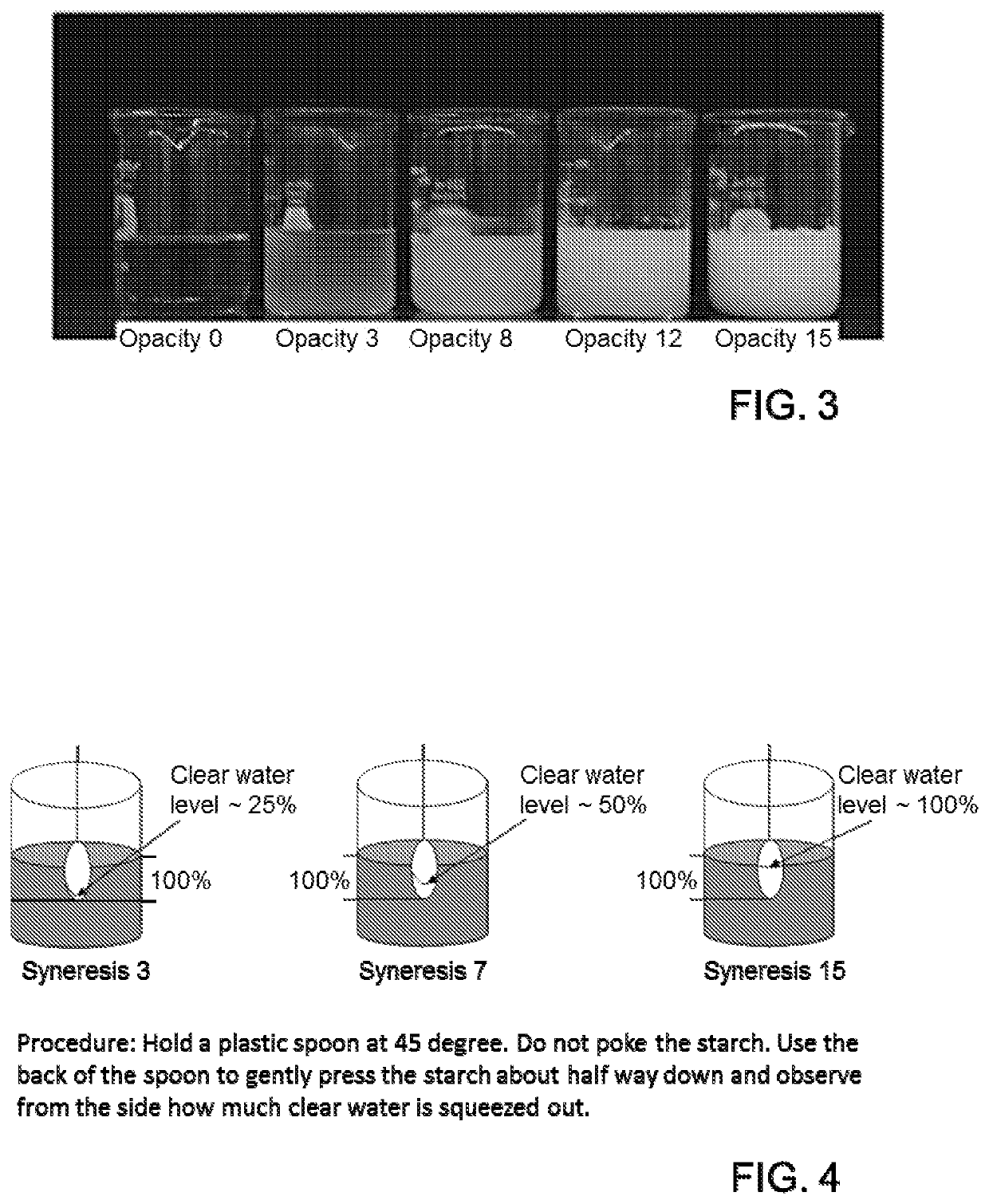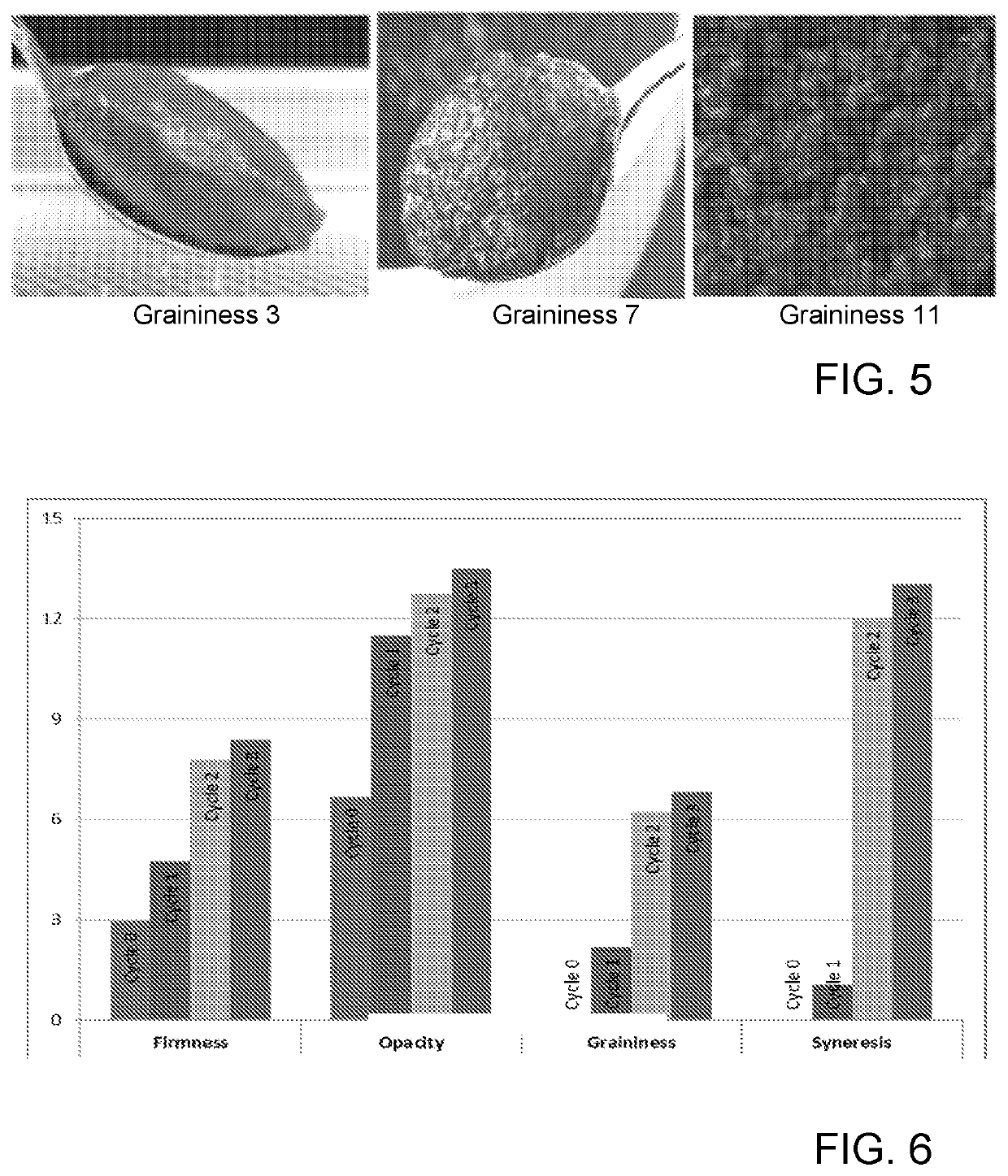Inhibited Waxy Starches and Methods of Using Them
- Summary
- Abstract
- Description
- Claims
- Application Information
AI Technical Summary
Benefits of technology
Problems solved by technology
Method used
Image
Examples
example 1
and Sedimentation Volume of Inhibited Waxy Starches
[0105]The waxy starch feedstock is subjected to a pH adjustment using one of the following pH-adjusting agents: formic acid, propionic acid, butyric acid, oxalic acid, lactic acid, malic acid, citric acid, fumaric acid, succinic acid, glutaric acid, malonic acid, tartaric acid, itaconic acid, aconitic acid, oxalosuccinic acid, ketoglutaric acid, and carbonic acid, as well as salts thereof (e.g., potassium and / or sodium salts, which can be generated in situ by neutralization of the acid). The pH-adjusting agent is contacted with the starch feedstock in slurry in liquid (e.g., water) under stirring for a few minutes. The pH adjustment can be done in the range of pH from 3.5 to 7.0. The amount of the pH-adjusting agent relative to the starch can vary, for example, from 0.01-30 wt % on a dry solids basis weight of starch. After the pH-adjusting agent is contacted with the starch, the starch (i.e. while still in contact with pH-adjusting...
example 2
Branch Chain Length Distribution Analysis—Valley-to-Valley Method
[0108]Branch chain length distributions were determined as described above for native or inhibited waxy starches described herein, using the valley-to-valley method. The results are shown in FIGS. 1 and 2, which indicates that the inhibited waxy tapioca starches of the disclosure have an amylopectin fraction with DP13-24 of no more than 48.0%, while other inhibited starches have the amylopectin fraction with DP13-24 in excess of 48.5%; and that the inhibited waxy tapioca starches of the disclosure have a ratio (DP13-24−DP6-12) / (DP13-24+DP6-12) less than 25.0%, while other inhibited starches have a ratio (DP13-24−DP6-12) / (DP13-24+DP6-12) greater than 25.5%. Detailed data are provided in the table below, in which replicates for each material are provided.
TABLE 2Valley-to-Valley branch chain length profilesof native and inhibited starchesDP6-12DP13-24StarchReplicate(v-to-v, %)(v-to-v, %)Ratio (%)Native waxy128.5047.8425.3...
example 3
aw Stability of Inhibited Waxy Starches
[0109]A set of experiments was performed to investigate various textural attributes with respect to freeze-thaw stability of the starches of the disclosure. To evaluate textural attributes, various starches of the disclosure and commercial inhibited waxy starches based on maize, wheat, or tapioca were cooked at 5% solids in deionized water by suspending a container (i.e. glass jar) containing the slurry in a 95° C. water bath and stirring with a glass rod or metal spatula for 8 minutes, then covering the container and allowing the paste to remain at 95° C. for an additional 20 minutes. The container was removed from the bath and allowed to cool on the bench. The resulting paste was brought back to the initial weight by addition of water (i.e. to replace any evaporated water) and mixed well. The glass jars that were to be used for the first, second and third freeze-thaw cycles were placed into a freezer (−18° C.) such that the jars did not touch...
PUM
| Property | Measurement | Unit |
|---|---|---|
| Fraction | aaaaa | aaaaa |
| Fraction | aaaaa | aaaaa |
| Fraction | aaaaa | aaaaa |
Abstract
Description
Claims
Application Information
 Login to View More
Login to View More - R&D
- Intellectual Property
- Life Sciences
- Materials
- Tech Scout
- Unparalleled Data Quality
- Higher Quality Content
- 60% Fewer Hallucinations
Browse by: Latest US Patents, China's latest patents, Technical Efficacy Thesaurus, Application Domain, Technology Topic, Popular Technical Reports.
© 2025 PatSnap. All rights reserved.Legal|Privacy policy|Modern Slavery Act Transparency Statement|Sitemap|About US| Contact US: help@patsnap.com



